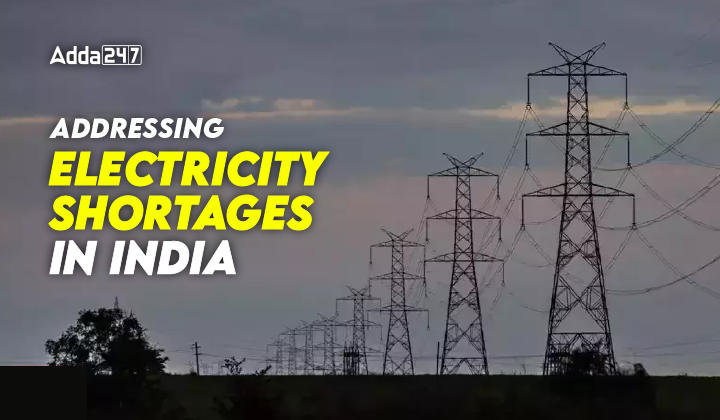Table of Contents
India faces electricity shortages due to increased demand and logistical challenges in coal supply, not a fundamental scarcity of coal. Misinterpretations of policy advisories and over-reliance on imports exacerbate cost and supply issues.
Electricity Shortages in India Highlights
Rising Electricity Demand: The combination of hot weather, unpredictable climate patterns, and economic growth is leading to increased electricity consumption.
Coal Shortage Misconception: The perceived shortage of domestic thermal coal, crucial for power generation, is often blamed for electricity deficits. For instance, in August 2023, a shortfall of 840 million units was reported, amounting to only 0.55% of the total demand.
Logistical Challenges: The real issue lies not in coal scarcity but in logistical hurdles, particularly in transporting coal from mines to power plants. This was highlighted by the Ministry of Power, pointing out limitations within the railway network.
Temporary Solutions: With coal being a key resource, the interim focus has been on finding alternative coal sources. However, there’s a common misconception that imports are the only solution.
Domestic Alternatives: Coal India Ltd offers a significant portion of its coal through spot auctions at competitive prices, yet many plants overlook this option due to logistical or other constraints.
Import Dependency: The Ministry of Power’s advisory for power plants to monitor coal stocks and import as needed (up to 6% by weight) has been mistakenly interpreted as a mandate, leading to unnecessary imports and increased costs.
Cost Implications: The misinterpretation of the advisory could lead to higher electricity prices for consumers, given the significant role of coal in India’s energy mix. A more prudent approach could mitigate these costs.
Generation Disparities: Not all power plants face the same issues. Plants near coal mines, for example, generally have more stable coal supplies than those located farther away.
Strategic Focus: The discourse should shift from defaulting to coal imports to addressing logistical challenges and exploring domestic coal options to prevent shortages.
Regulatory and Utility Role: Regulatory bodies and utilities must ensure power plants are prepared for potential shortages with cost-effective solutions, sparing consumers from bearing the burden of inefficient coal procurement strategies.
Findings of the IEA Report 2024
Coal Dependence Continues
- Coal remains India’s primary energy source through 2026, expected to contribute 68% to electricity demand.
- Annual growth of coal-fired power generation at 2.5% from 2024 to 2026.
Renewable Energy Stability
- Renewable sources maintained a 21% share in 2023, balanced by an increase in solar and wind against a decrease in hydropower.
- Added close to 21GW of renewable capacity in 2023, making up 44% of total installed capacity.
Rising Electricity Demand
- 7% demand increase in 2023 due to economic growth and higher cooling needs.
- Anticipated demand growth at 6.5% annually between 2024-2026.
Global Perspective
- India’s demand growth is projected to surpass China by 2026, aligning with the world’s highest.
- Approximately 85% of new capacity is expected from emerging economies, led by China and India.
Hydropower and Coal Blending
- Hydropower saw a 15% reduction in 2023 due to variable weather patterns.
- The government mandates a minimum of 6% imported coal blend until March 2024 to ensure a stable power supply.
Energy Diversification
Expansion in wind and solar capacities, alongside development of large hydro and nuclear projects.
India’s Power Sector Overview (as of May 2023)
- Total Installed Capacity: 417 GW
- Fossil Fuel Share (including Coal): 56.8%
- Renewable Energy Share (including Hydropower): 41.4%
- Nuclear Fuel Share: 1.60%
Renewable Energy Goals:
- Achieve 500 GW non-fossil fuel capacity by 2030
- Meet 50% of energy needs with renewables by 2030
- Cut CO2 emissions by 1 billion tons by 2030
- Reduce carbon intensity by over 45% by 2030
- Target Net-Zero emissions by 2070
Updated National Commitments: Enhanced emissions intensity reduction goal to 45% by 2030 from the 2005 baseline, as per the updated Nationally Determined Contribution (NDC) in August 2022.
Way Forward
- Enhancing logistics and infrastructure for coal transportation is crucial to mitigating shortages and reducing dependency on imports.
- Accelerating the transition to renewable energy sources and improving grid integration can help meet rising demand sustainably.
- Strengthening regulatory oversight to ensure power plants adopt cost-effective and efficient procurement strategies.
- Promoting energy efficiency and conservation measures to manage demand and reduce the overall energy burden.
Conclusion
- Addressing India’s electricity challenges requires a multifaceted approach that includes both immediate logistical improvements and long-term energy diversification.
- By focusing on sustainable solutions and efficient energy use, India can ensure a reliable power supply while moving towards its ambitious renewable energy and emission reduction targets.
- The transition to a more sustainable energy mix, coupled with improved energy infrastructure, will be key in securing India’s energy future.
- Strategic and prudent policy implementation, aligned with technological advancements, will be essential in navigating the complexities of India’s power sector.



 TSPSC Group 1 Question Paper 2024, Downl...
TSPSC Group 1 Question Paper 2024, Downl...
 TSPSC Group 1 Answer key 2024 Out, Downl...
TSPSC Group 1 Answer key 2024 Out, Downl...
 UPSC Prelims 2024 Question Paper, Downlo...
UPSC Prelims 2024 Question Paper, Downlo...




